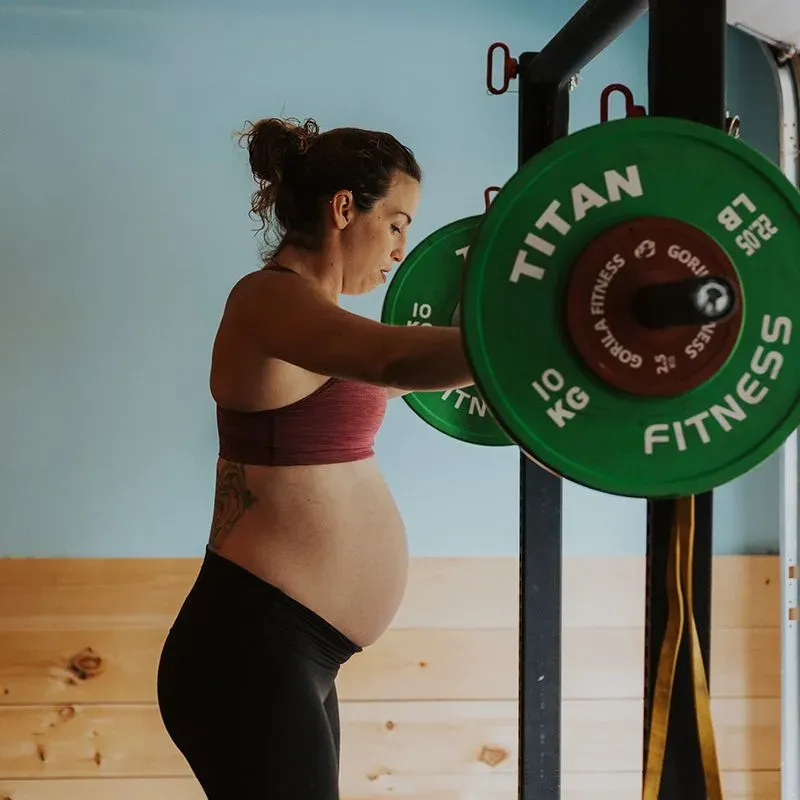Hard Worker Highlight: Christina Prevett, Pelvic Floor Specialist
Earlier this week, we spoke to one of our incredible #HARDWORKERS, Christina Prevett, a pelvic floor specialist and a member of our HWPO FLAGSHIP program. She shares her knowledge of pelvic floor health, training whilst pregnant or postpartum and the relationship between fitness and the menstrual cycle.
Mar 12, 2023
Who is Christina Prevett?
Christina is a pelvic floor physical therapist specializing in high-intensity exercise (specifically CrossFit®) during pregnancy, returning postpartum, or rehabilitating pelvic health issues.
She’s published research on heavy lifting during pregnancy and uses this research to help pregnant and postpartum moms navigate exercise through her program, The Barbell Mamas. Christina is a mom of two and has competed both pregnant and postpartum in CrossFit®, powerlifting, and weightlifting.
The relationship between moms and fitness
Christina shared that often after giving birth and experiencing drastic physical changes, many individuals struggle to return to the same level of physical activity that they did before getting pregnant.
“There are so many messages to moms that say, ‘You’re going to retire from your sport when you get pregnant.”
However, many of the top elite CrossFit® athletes are mothers, setting examples for anyone who gives birth. You don’t have to give up being active. You can be strong and fit as a mom.
Narratives surrounding high-intensity sports like CrossFit® are changing. Athletic issues, specifically for women (both moms and women without kids), are discussed more frequently, and pelvic health is an important part of those discussions.

CrossFit® moms are just really shaking things up regarding our expectations after having kiddos.
Who can experience pelvic health problems?
The pelvic floor isn’t often discussed among athletes. But in reality, it’s just like any other group of muscles. Sometimes, just like other muscles, it can become tight, and we need to relax it, or when it becomes weak, we need to strengthen it. Only when we approach it this way do we know how to fix it, like we would any other muscle group.
Anyone, regardless of age, gender, and physical ability, can experience pelvic floor dysfunction. Christina listed some symptoms for both women and men that may indicate pelvic floor issues.
Many symptoms can indicate pelvic floor problems for women: Leaking when you don’t want to leak, having to go to the bathroom frequently when that’s not normal for you, painful sex, lower back pain, and gas releasing unintentionally. These can all be reasons to visit a pelvic floor specialist.
Pelvic health is represented much more for women than men because women are at a higher risk for pelvic floor dysfunction. However, men can still experience pelvic floor problems and should know the signs. For men, hemorrhoids, hernias, unintentional farting at the bottom of a squat, testicular pain, and erectile dysfunction are all symptoms of pelvic floor dysfunction.
The relationship between the pelvic floor and different phases of the menstrual cycle
Christina talked in-depth about the menstrual cycle and how changing hormone levels at each phase can affect how individuals feel, specifically from a pelvic floor perspective.
In general, women feel the best during ovulation and feel the worst 2-3 days before their periods, in the late luteal and early follicular phases. Christina said that during the different stages of the menstrual cycle, women don’t have to alter their exercise routines completely and instead urged them to listen to their bodies. Instead of changing your workout entirely, maybe lower the weights or reduce the volume.
“We may want to bring some of our percentages down and just know we’re not going to feel that great that day.”
Because of the shedding and thickening, blood flow, and blood exiting the vagina during menstruation, it’s common for people to experience an increase in pelvic floor issues during the menstruation phase of the menstrual cycle. With more frequent symptoms, understand that your hormones are likely behind them and listen to your body. Don’t think you can’t work out if you’re itching to lift something heavy.

Getting back into exercise after giving birth
Giving birth completely changes your body, and it can be terrifying to try and work out again after that drastic change in a body you don’t recognize. Christina emphasized the importance of listening to your body and doing what you feel comfortable with regarding exercise.
New moms are often told to refrain from exercise for six weeks postpartum, but that’s not the right course of action for everyone. Slowly return to training and do foundational work around contracting and relaxing your pelvic floor to build back your core canister strength gradually. You’ll already be lifting immediately after delivery when carrying your baby, lugging around a car seat, and several other day-to-day actions, so you’ll remain active either way.
Postpartum bodies are different. Get used to it at your own pace and listen to your changed body. Christina highlighted it’s essential to remember to start your warmups by activating your pelvic floor and core muscles. Integrate those workouts with other movements as you start exercising again.
Christina emphasized that you likely won’t start touching the same weights you did before giving birth until about 9-12 months postpartum. Even then, you may still be readjusting to specific movements. Celebrate postpartum PRs and wins.
Christina shared a ton of her expert knowledge with us in our conversation this week. We discussed what someone should expect when they visit a pelvic floor physical therapist like herself to get a pelvic floor assessment amongst many other things. We’ve touched on some of the main points but watch the entire discussion on Circle.
Connect with Christina
We are so grateful to Christina for sharing so much valuable information with us. Watch the recording of our conversation with Christina or check out her Instagram @christina_prevett and @thebarbellmamas to learn more about pelvic health or scaling options for anyone experiencing pelvic floor dysfunction.

Christina shares her knowledge with us.
We discussed what someone should expect when they visit a pelvic floor physical therapist like herself to get a pelvic floor assessment amongst many other things. We’ve touched on some of the main points but watch the entire discussion on our circle channel.





